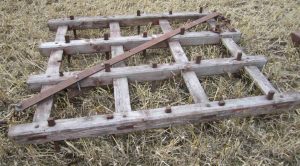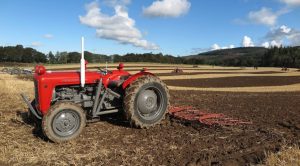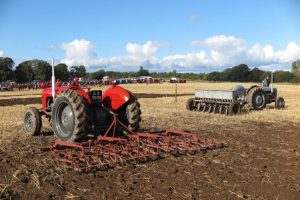“The Gentleman Farmer: being an attempt to improve agriculture, by subjecting it to the test of rational principles” of Lord Kames, Henry Home, was an agricultural best-seller of its day. It was first published in 1776. By the early 1800s it had gone through six editions. No other Scottish agricultural book had that level of success.
Kames showed himself to be a practical agriculturist, and provided comments on the implements and machines used. He was both positive but also critical on the merits of them, and made a range of suggestions on how they could be improved.
Kames provides a detailed account of the harrow, an important implement for making a good seedbed for a range of crops. It is worth quoting at length for his observations, and to show what farmers and agriculturists were using for harrows. This account is from the 1798 edition of his book:
“Harrows are commonly considered as of no use to cover the seed. They have another use scarce less essential, which is to prepare land for the seed. This is an article of importance for producing a good crop. And to shew how imperfectly either of these purposes is performed by the common harrow, take the following account of it.
The harrow commonly used is of different forms. The first I shall mention has two bulls, four feet long and eighteen asunder, with four wooden teeth in each. A second has three bulls and twelve wooden teeth. A third has four bulls, and twenty teeth, of wood or iron, ten. Eleven, or twelve inches asunder. Now, in fine mould the last may be sufficient for covering the seed; but none of them are sufficient to prepare for the seed any ground that requires subduing. The only tolerable form is that with iron teeth; and the bare description of its imperfections, will shew the necessity of a more perfect form. In the first place, this harrow is by far too light for ground new taken up from the state of nature, for clays hardened with spring-drought, or for other stubborn soils: it floats on the surface, and after frequent returns in the same track, nothing is done effectually. In the next place, the teeth are too thick set, by which the harrow is apt to be choked, especially where the earth is bound with roots, which is commonly the case. At the same time, the lightness and number of teeth kept the harrow upon the surface, and prevent one of its capital purposes, that of dividing the soil. Nor will fewer teeth answer for covering the seed properly. In the third place, the teethe are too short for reducing a coarse soil to proper tilth; and yet it would be in vain to make them longer, because the harrow is too light for going deep into the ground. Further, the common harrows ate so ill constructed, as to ride at every turn one upon another. Much time is lost in disengaging them. What pity is it, that an industriuous farmer should be reduced to such an imperfect instrument, which is neither fit to prepare the ground for seed, nor to cover it properly! And I now all, that it is equally unfit for extiripating weeds. The ground is frequently so bound with couch-grass, as to make the furrow-slice stand upright, as when old lea is ploughed: notwithstanding much labour, the grass-roots keep the field, and gain the victory. What follows? The farmer at last is reduced to the necessity of leaving the weeds in peaceable possession, because his field will no longer bear corn.
A little reflection, even without experience, will make it evident, that the same harrows, whatever be the form, can never answer all the different purposes of harrowing, nor can operate equally in all different soils, rough or smooth, firm or loose. Looking back not many years above thirty, no farmer in Scotland had the slightest notion of different ploughs for different purposes. The Scotch plough was the only one known. Different ploughs are now introduced; and it is full time to think of different harrows. Rejecting the common harrows, as in every respect badly constructed, I boldly recommend the following, I use three of them of different forms, for different purposes. They are all of the same weight, drawn each by two horses. Birch is the best wood for them, because it is cheap, and not apt to split. The first is composed of four bulls, each four feet ten inches long, three and a quarter inches broad, and three and a half deep; the interval between the bulls eleven and three fourth inches; so that the breadth of the whole harrow is four feet. The bulls are connected by four sheths, which go through each bull, and are fixed by timber nails driven through both. In each bull five teeth are inserted, ten inches free under the bull, and ten inches asunder. They are of the same form with those of the brake, and inserted into the wood in the same manner. Each of these teeth is three pounds weight; and where the harrow is made of birch, the weight of the whole is six stone fourteen pounds Dutch. An erect bridle is fixed at a corner of the harrow, three inches high, with four notches for drawing higher or lower. To this bridle a double tree is fixed for two horses drawing abreast, as in a plough. And to strengthen the harrow, a flat rod of iron is nailed upon the harrow from corner to corner in the line of the draught.
The second harrow consists of two parts, connected together by a crank or hinge in the middle, and two chains of equal length, one at each end, which keep the two parts always parallel, and at the same distance from each other. The crank is so contrived, as to allow the two parts to ply to the ground like two unconnected harrows; but neither of them to rise above the other, more than if they were a single harrow without a joint. Ina. Word, they may form an angle downward, but not upward. Thus they have the effect of two harrows in curved ground, and of one weighty harrow in a plain. The harrow is composed of six bulls, each four feet long, three inches broad, and three and a half deep. The interval between the bulls nine and a half inches; which makes the breadth of the whole harrow, including the length of the crank, to be five feet five inches. Each bull has five teeth, nine inches free under the wood, and ten inches asunder. The weight of each tooth is two pounds, the rest as in the former.
The third consists also of two parts, connected together like that last mentioned. It has eight bulls, each four feet long, two and a half inches broad, broad, and three deep. The interval between the bull sis eight inches; and the breadth of the whole harrow, including the length of the crank, is six feet four inches. In each bull are inserted five teeth, seven inches free under the wood, and ten and a half inches asunder, each tooth weighing one pound. The rest as in the two former harrows.
These harrows I hold to be a considerable improvement. They ply to be a considerable improvement. They ply to curved ground like two connected harrows, and when drawn in one plain, they are in effect one harrow of double weight, which makes the teeth pierce deep into the ground. The imperfection of common harrows, mentioned above, will suggest the advantages of the set of harrows here recommended. The first is proper for harrowing land that has lain long after ploughing, as where oats are sown on a winter-furrow, and in general for harrowing stiff land: it pierces deep into the soil by its long teeth, and divides it minutely. The second is intended for covering the seed: its long teeth lays the seed deeper than the common harrow can do; which is no slight advantage. By placing the seed considerably under the surface, the young plants are, on the one hand, protected from too much heat, and, on the other, have sufficiency of moisture. At the same time, the seed is so well covered that none of it is lost. Seed slightly covered by the common harrows, wants moisture, and is burnt up by the sun; beside, that a proportion of it is left upon the surface uncovered. The third harrow supplies what may be deficient in the second, by smoothing the surface, and covering the seed more accurately. The three harrows make the ground finer and finer, as heckles do lint; or, to use a different comparison, the first harrow makes the bed, the second lays the seed in it, the third smooths the cloathes. These advantages are certain. If any man doubt, let him try the experiment, and he will find the effect of them in his crops. I can say so with assurance from the experience of many years. They have another advantage not inferior to any mentioned; they mix manure with the soil more intimately than can be done by common harrows; and on such intimate mixture depends greatly the effect of manure. To conclude, these harrows are contrived to answer an established principle in agriculture, That fertility depends greatly on pulverising the soil, and on an intimate mixture of manure with it, whether dung, lime, marl, or any other.”
What do you think of Kaimes’ views on the roller?




